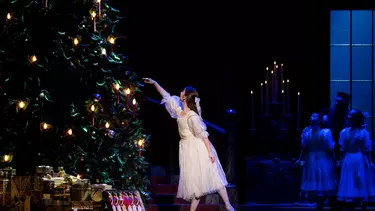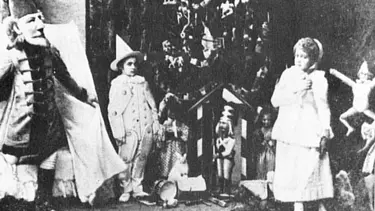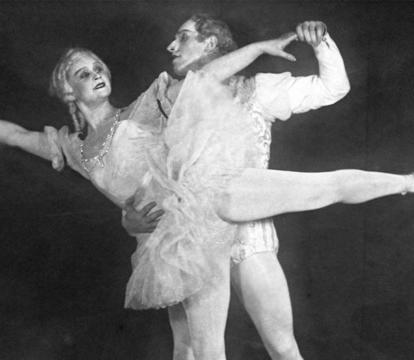A tough nut to crack
How The Nutcracker cracked its way into the ultimate Christmas tradition.
Born in 1816 from E.T.A Hoffmann’s dark and bizarre story of The Nutcracker and the Mouse King, the ballet we know and love today has become a cornerstone of the Christmas holiday tradition. First performed at the Mariinsky Theatre in St. Petersburg, Russia in 1890, The Nutcracker’s inaugural performance was widely considered a failure by critics. It was not until George Balanchine’s rendition with the New York City Ballet in 1954, more than a century following The Nutcracker’s inception, that the story established itself as the quintessential Christmas tradition we know today.
In keeping with tradition, John F. Macfarlane’s set for the Australian Ballet’s 2019 performance of The Nutcracker puts on as big a performance as the dancers, boasting an oversized Christmas tree and rich, elaborate costumes.
Act I
It’s a snowy evening in the Stahlbaum household and Dr. and Mrs. Stahlbaum and their two children, Fritz and Marie, are throwing their annual Christmas Eve party. The home is dressed head to toe in Christmas trimmings and there are presents, games, and dancing for all. Herr Drosselmeyer, Marie’s beloved magician godfather, presents her with a toy nutcracker—she is delighted by the gift and falls asleep with it after the party is over. As the clock chimes midnight, something strange occurs—giant mice scurry into the room and the Christmas tree begins to grow taller and taller. Everything in the room disappears except for Marie’s toy Nutcracker and Fritz’s toy soldiers, who have all come to life. The Nutcracker leads the soldiers into battle to fight the evil Mouse King, who is soon slain by the Nutcracker with Marie’s help. Upon the Mouse King’s defeat, the ancient curse is lifted and the Nutcracker transforms into a handsome prince. Marie and the Prince celebrate and dance together before they travel into a magical forest.
Act II
Marie and the Prince arrive in the Land of Sweets, ruled by the Sugar Plum Fairy. In this strange and wonderful land conjured up by Drosselmeyer, flowers and dancers from many different realms perform enchanting dances for the children. The Mouse King returns but is banished by the Prince and Drosselmeyer. The Sugar Plum Fairy performs one last majestic dance before the children bid farewell and soar off in a sleigh guided by flying reindeer.

1816 - The birth of The Nutcracker
Prussian author E.T.A. Hoffmann writes the fable of The Nutcracker and the Mouse King. It’s dark and resembles little of the magical story we know and love today.
After being gifted a toy nutcracker for Christmas, young daughter Marie is thrust into a world where toys and mice battle it out. The Nutcracker leads the army of toys, while they fight the seven-headed mouse king. The story delves into the desperate and depraved side of mankind and does not contain any of the sugar or fluff we have come to associate with The Nutcracker today.

1845 - Alexandre Dumas Revises Hoffmann's Story
Alexandre Dumas, the French writer famous for such works as The Count of Monte Cristo and The Three Musketeers, revises the rather dark tale of The Nutcracker and the Mouse King and creates The Story of a Nutcracker.
Dumas’ repackaging of Hoffmann’s original work includes changing the names of characters and embellishing the story, giving it a new warmth and sense of romance. Dumas’ popularity at the time allowed the story to reach a large audience and the story began to pick up traction throughout Europe through the latter half of the decade.

1891 - The Nutcracker Ballet is born
Following the success of Pyotr Ilyich Tchaikovsky’s The Sleeping Beauty, Ivan Vsevolozhsky, Director of the Imperial Theatres in Russia commissions the composer to write the score for The Nutcracker ballet. Marius Petipa is charged with choreographing the ballet, which is later finished by Lev Ivanov.

Early 1892 - Instrumental influences
On his way to the United States, while in Paris, Tchaikovsky hears a celesta for the first time. The celesta ends up being used as the primary instrument in the famous ‘Dance of the Sugar Plum Fairy’.
Charmed by its whimsical lilt, and fearful of other composers using it in their compositions first, Tchaikovsky secretly ships a celesta back to Russia where he begins writing it into The Nutcracker score.

18 December, 1892 - A rocky start
The Nutcracker premieres at the Imperial Mariinsky Theater in St. Petersburg, Russia. The role of the Sugar Plum Fairy is danced by Italian ballerina Antoinetta dell’Era. The ballet is poorly received by critics and is swiftly removed from the company’s repertory.
Tchaikovsky cuts a 20-minute version of the score and calls it the Nutcracker Suite. The Suite keeps the Nutcracker alive until 1954 when George Balanchine revives the ballet for the New York City Ballet.

1893 - Tchaikovsky's death
Pyotr Ilyich Tchaikovsky passes away at the age of 53, not knowing what a success the ballet was due to become.
1919 - First performance at the Bolshoi Theatre
The Bolshoi Ballet performs The Nutcracker Ballet for the first time in Moscow.
1934 - The Nutcracker travels overseas
The Nutcracker is performed for the first time outside Russia at Sadler’s Wells Theatre in London.

1940 - America's first taste of The Nutcracker
Almost half a century passes by the time Tchaikovsky’s score features in the Disney animated movie Fantasia. American audiences fall in love with music, reigniting interest in the nearly 50- year old ballet which was initially considered “an insult”.
The Ballet Russe de Monte Carlo tours the United States performing a condensed version of The Nutcracker. The performances are well-received, and the Ballet Russe continues to dance The Nutcracker throughout the U.S. for the next decade.

1944 - Growing popularity
On Christmas Eve 1944, The San Francisco Ballet presents the first full version of The Nutcracker by an American Ballet company at San Francisco’s War Memorial Opera House. American audiences begin to grow more familiar with the story.

1954 - The birth of an American institution
The New York City Ballet premieres George Balanchine’s full-length rendition of The Nutcracker in New York. When asked to edit out the growing Christmas tree due to budget constraints, Balanchine retorts: “No, the ballet is the tree." The show is a revelation in the American ballet scene and becomes an instant success. For the rest of the century, The Nutcracker would be performed throughout the US and around the world. It quickly elevates itself to one of the most famous ballets of all time and a cornerstone of the Christmas holiday tradition.

The Nutcracker today
Dance and ballet companies around the world continue to perform countless productions of The Nutcracker each year, and audiences continue to flock to the performances.
The enchanting make-believe world of The Nutcracker has become as embedded in the Christmas tradition as stockings and candy canes. The story has transformed from an obscure 19th-century European fable into an American institution whose influence has spread across dance and ballet companies around the globe.

The Australian Ballet’s The Nutcracker is showing until 18 December, followed by Storytime Ballet: The Nutcracker until 4 January in the Joan Sutherland Theatre.
Help us keep the Opera House open to everyone, forever.
Your gift today can bring a great artist to the stage, enable a disadvantaged child’s visit, preserve this beloved icon, and much more.
We’re not for profit and raise over 90% of our costs from non-government sources.
We can’t do it without you.
